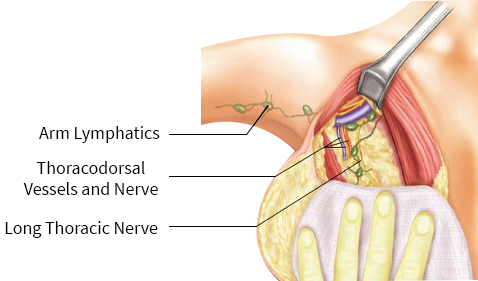Axillary Lymph Node Dissection
When and why is Axillary Lymph Node Dissection done?
- Breast cancer spreads through small lymphatic channels to the lymph nodes in the axilla (armpit). Lymph nodes are swellings in the axilla which filter the lymphatic fluid. When the lymph nodes get enlarged, they can be felt in the axilla. The lymph nodes can get enlarged due to breast cancer, infection and many other reasons. To confirm that the swellings are due to breast cancer, a test called Fine Needle Aspiration Cytology (FNAC) is done if the lymph node can be felt in the axilla. If no lymph node swelling can be felt, we find out whether the breast cancer has spread to the axilla by a technique called Sentinel Lymph Node Biopsy (SLNB). If we find that the breast cancer has spread to the axilla by FNAC or SLNB, we would then need to do an axillary dissection.
What is Axillary Lymph Node Dissection?

- As a means to contain the spread of cancer that has spread on to the axilla, the lymph nodes, lymphatic tissue and fibrofatty tissue are removed from the axilla and at the same time the important blood vessels and nerves in the region are not damaged
Is this operation done separately from the operation to remove the cancer or the breast?
- Usually, Axillary Lymph Node Dissection is done along with the operation to remove cancer or the breast. Sometimes when there is a recurrence of a tumour in the axilla, we would then do this as a separate procedure.
What is the post operative protocol when axillary lymph node dissection is done?
- After Axillary Lymph Node dissection, there is a lot of lymphatic fluid and serous collection in the axilla which will be drained out by a tube from the axilla. The amount of fluid in the drain will be noted daily. The amount of fluid drained is expected to decrease with time and when the amount of drainage is little, the drain is then removed. The drain stays in the armpit for around 5 to 7 days. For some people, this may take longer for the drains to come out depending on the output from the drain. The patient can walk the next day. Gradual exercises are started for the upper limb corresponding to the side operated to remove the stiffness associated with the operation and also to reduce lymphoedema. The patients are discharged as soon as the drains are removed or when the patient is comfortable in taking care of the drains.
What could be the side effects of this procedure?
- Haematoma The armpit is an area which has a lot of small blood vessels which can easily bleed. A lot of effort is made to reduce the chance of bleeding. However, there is a small chance of bleeding later as the blood vessel that was closed can leak later due to changes in blood pressure. If that happens, then the patient is taken to the theatre immediately to drain the blood.
- Seroma Seroma is a collection of serous fluid which gets collected. This is usually aspirated repeatedly with a needle. If on repeated aspirations, the seroma doesn’t settle, then the patient may be taken to the operation theatre for evacuation of the seroma
- Lymphoedema As the lymphatic channels and lymph nodes in the armpit are removed, in 30% of individuals there is swelling of the corresponding upper limb which can be prevented by wearing compression garments and by some exercises
Why Ganga Hospital?
- Axillary Lymph node dissection is a very important component of the treatment for breast cancer as the lymph nodes need to be removed in toto and at the same time, the vital blood vessels and the nerves shouldn’t be damaged. After the axillary lymph node dissection, we take a photograph and give it to the patient for her records. By being transparent, we ensure that we do a thorough dissection in every case.




